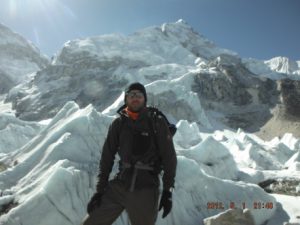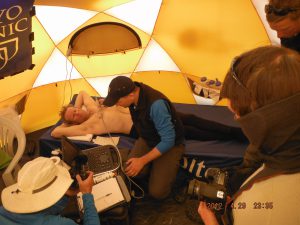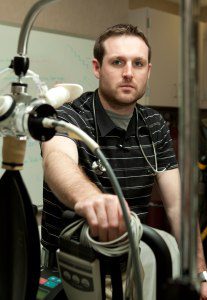August 21, 2012
Alex Kasak ’09 discovers adventure – and a career in exercise physiology – on the shoulders of Mt. Everest.

Alex Kasak ’09 sits in a coffee shop across the street from Saint Mary’s Hospital in Rochester, taking a mid-afternoon break from his work as a research assistant in the Department of Physiology and Biomedical Engineering at Mayo Clinic.
He starts describing his twenty-fifth birthday, celebrated just a couple of weeks ago. Nothing special, he says. The usual office affair. A cake, maybe a little lumpy. Candles to wish upon and blow out. The traditional strains of “Happy Birthday to You.”
Kasak seems unfazed that the party took place at a base camp on the approach to Mt. Everest, a world away from his hometown of Austin, Minnesota. That he was perched on a 400-foot-thick slab of ice. That Sherpa porters baked the cake. That, in the rarified air of 17,600 feet, summoning the breath to blow out candles took a little extra effort. That the chorus serenading him included his fellow members of the Mayo Everest Research Team and a group of climbers preparing to summit the world’s highest peak.
Alex’s birthday cake
Although he turned a year older on the slopes of Everest, Kasak was the youngest member of the Mayo team. Five other researchers in
Kasak’s lab group made the month-long trek to the Himalayas, along with a contingent of scientists, expedition specialists, reporters, photographers, and nine climbers backed by the National Geographic Society and outfitter The North Face.
The goal, according to Kasak, was to conduct “every physiological test you could imagine” to measure the human body’s responses to extreme altitudes and conditions. The Mayo team is using the data it collected on Everest to learn not only how the body adapts to high altitude, but also to understand the physiology of cardiovascular disease.
“Many of the symptoms observed at altitude – back-flow between heart chambers, fluid accumulation in the lungs, muscular wasting – are the same as seen with cardiac disease,” says Kasak, a graduate of the exercise science program at Winona State University.
A focus of the project, led by Mayo researcher Dr. Bruce Johnson, is how the lungs handle fluid changes. That’s commonly the problem that forces climbers down from the mountain, and patients with heart disease into the hospital.
Kasak and the Mayo Everest Research Team spent months preparing for the trip, which included performing baseline physiological testing on the climbers and control groups, and selecting, optimizing, and packing about 1,500 pounds of testing equipment.
Early April to late May is prime season on the 29,000-foot Everest, when the weather is less severe and Sherpa guides have established climbing routes. The conditions remain unpredictable, and dangerous: during the 2012 season, there were about 500 summits with ten confirmed deaths.
Kasak’s team, supported by a coterie of guides and porters, set up a full physiological testing lab at more than 3 miles above sea level. Despite the remote location on a glacier surrounded by towering peaks – and the constant sounds of creaking ice and falling rocks – Kasak says that the base camp was “like a small city with hundreds of tents,” that sheltered climbers waiting to scale Everest. “There was everything from a helicopter landing pad to wireless Internet,” says Kasak.
Getting there wasn’t easy, however. After flying first to Kathmandu, Nepal, and then to a village on the slopes of the Himalayas, Kasak and the Mayo group hiked 53 twisting miles to base camp. The trek took eight days, giving the team time to acclimate to the high altitude. Kasak says that living conditions along the way were Spartan. But the distinctive peak of Everest was always just around the next bend.
The Mayo Clinic team built a full physiology testing lab on the shoulders of Everest.
Kasak’s journey toward physiology research has been nearly as convoluted as the path to Everest.
As an undergraduate at Winona State, he was more interested in a career in strength and conditioning with a college athletics program or professional sports team. Right after earning his degree in exercise science in 2009, Kasak got his chance: a choice internship as a strength coach with the St. Louis Rams.
“I knew almost immediately that I couldn’t see myself going in that direction, not in the long term,” says Kasak. He returned home to Austin weighing his options.
A few years earlier Kasak completed a clinical experience in the same Mayo lab in which he now works. Bruce Johnson had been his advisor. Kasak revisited the lab – he says he’s uncertain about what led him back there – and eventually ran into Johnson.
Johnson offered Kasak a deal he couldn’t refuse: a research assistant position in a productive lab, with the opportunity to immerse himself in the nuts and bolts of physiological testing, albeit unpaid. Kasak worked for about eight months, putting in long hours and living with his parents in Austin to make ends meet.
The risk paid off for Kasak. He first moved to a half-time position in the lab and shortly after full-time. He has now been working with Johnson and his group of doctoral and post-doctoral students for about three years.
While Kasak knew that the focus of Johnson’s lab was respiratory physiology under various conditions, he was initially less aware that its research interests would send him around the world. In addition to working with the Everest climbers, Johnson’s group has also conducted testing in the Antarctic, Croatia, and the Swiss Alps.
“There’s no way to simulate the conditions of these areas,” says Kasak to explain what he terms “adventure physiology.” “Reproducing the reactions to trekking all day at altitude, sleeping in harsh conditions, and then doing it all again the next day.”
Alex Kasak at his Mayo Clinic physiology lab.
The Mayo Everest Research Team did its best, however, to recreate its research lab at its Himalayan base camp. Kasak and his fellow researchers set up in two large tents, packed with the equipment they brought up and powered by generators.
Maybe that’s why, a few weeks later, Kasak seems nonchalant when talking about Everest. He saw the outside of the tents only occasionally, except for a few hikes on the glacier. “I worked all day, every day, doing blood draws, body composition measurements, stress testing, organizing data,” he says.
“We even collected data while the climbers slept to measure heart rate, blood oxygen, breathing, brainwave patterns. It could be mentally taxing and physically exhausting.”
Kasak is unsure where he’ll spend his twenty-sixth birthday. Perhaps the question is a little unfair since he’s barely had time to thaw from the zero-degree nights on Everest, and the thousands of samples that await analysis in his lab across the street.
He’s certain, however, that he’s found his niche in research and is contemplating entering a graduate program in exercise physiology. The next adventure awaits.




